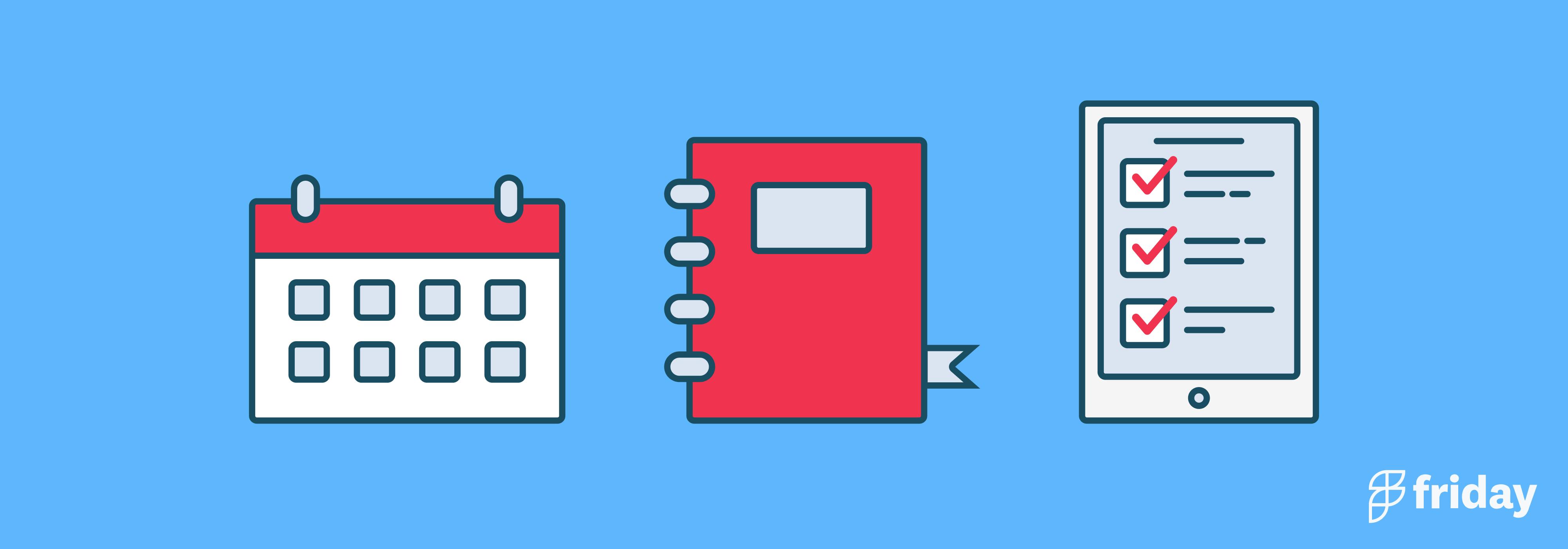The Fundamentals and Benefits of the Bullet Journal Daily Spread
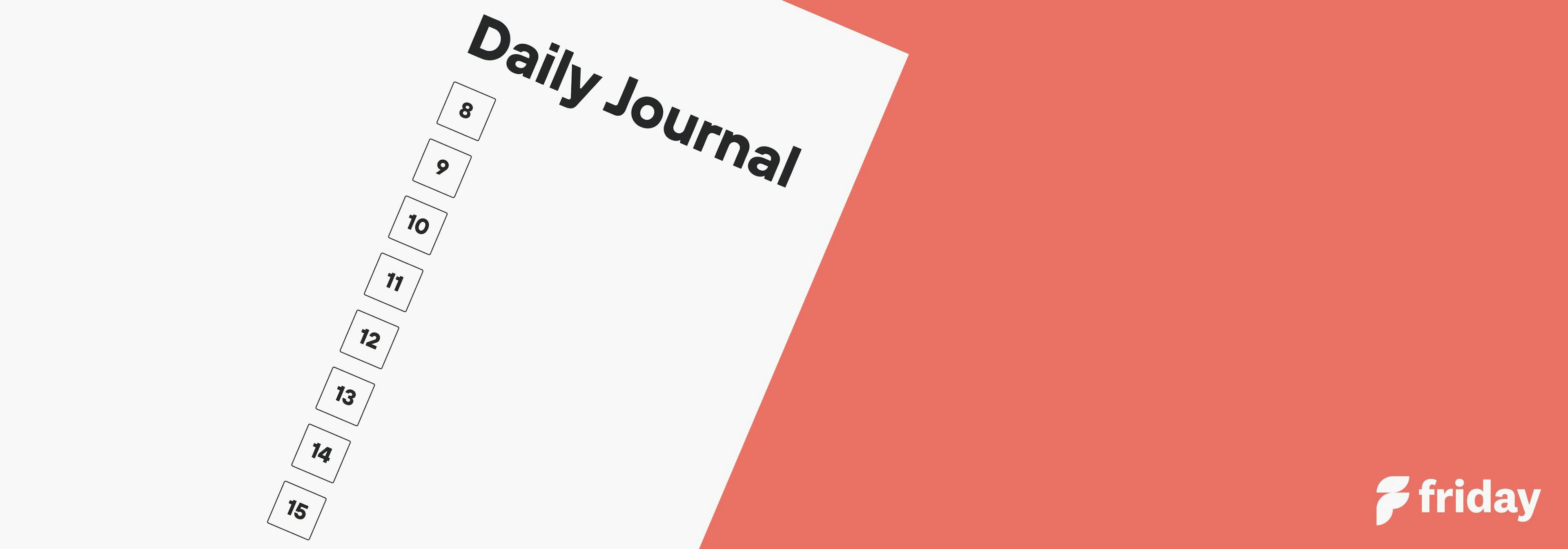
Regardless of how adept you become at something, there is always room for improvement. You might assume that being productive is an innate ability, tied to your self-determination and natural drive. In actuality, productivity is a methodology that can be learned, trained, and eventually mastered; then, like many refined skills, it can be made marketable and lucrative.
See how to use a digital bullet journal in Friday.
What is a daily spread for Bullet Journals?
A daily spread is solely focused on one particular day’s happenings, falling into the three categories of action, creation and reflection.
Generally, the fundamental sections of a daily spread are as follows:
Action:
- Tasks
- Events and Appointments
- Reminders
- Targets/Goals
- Notes (Specific to the Above)
Creation:
- Thoughts
- Ideas
- Sketches
- Notes (General)
Reflection:
- Diary
- Progress Check
- Migration of Unfinished Tasks
Alongside these staples are any supplementary sections that help you organize or reflect, such as:
- Habit Tracker
- Quotes or Inspirations
- Details of Day
- Gratitude Log
- Memories
- Finances
- Meal Plans
- Daily Mood
It’s important to remember that there is no one true example of a Bullet Journal. Bujo is an art form. The constitution of your journal is wholly dependent on your personal needs and desires.
From BulletJournal.com:
“Figuring out what you need your Bullet Journal to be is an important part of the process, a process that begins with regularly examining how you're spending your time and energy.”
You are trying to concisely visualize your day, so the page should work entirely for you. The daily spread is the bottom-up approach, meaning that your focus should be on one day, starting with tasks and responsibilities. This is contrary to your monthly spread, a top-down approach, which will assimilate your larger goals into smaller time frames.
Be Familiar with Rapid Logging
You first should become familiar with “Rapid Logging”, the core process of Bullet Journaling, and the heart of the daily spread, but many bloggers who talk about their journaling neglect to explore what Rapid Logging is. Rapid logging is much like traditional bullet-pointing, but with a focus on minimalism. Bullets are short-form sentences, paired with symbols that represent the relevant sections. You are also encouraged to “nest” your bullets with sub-points that add information or clarification.
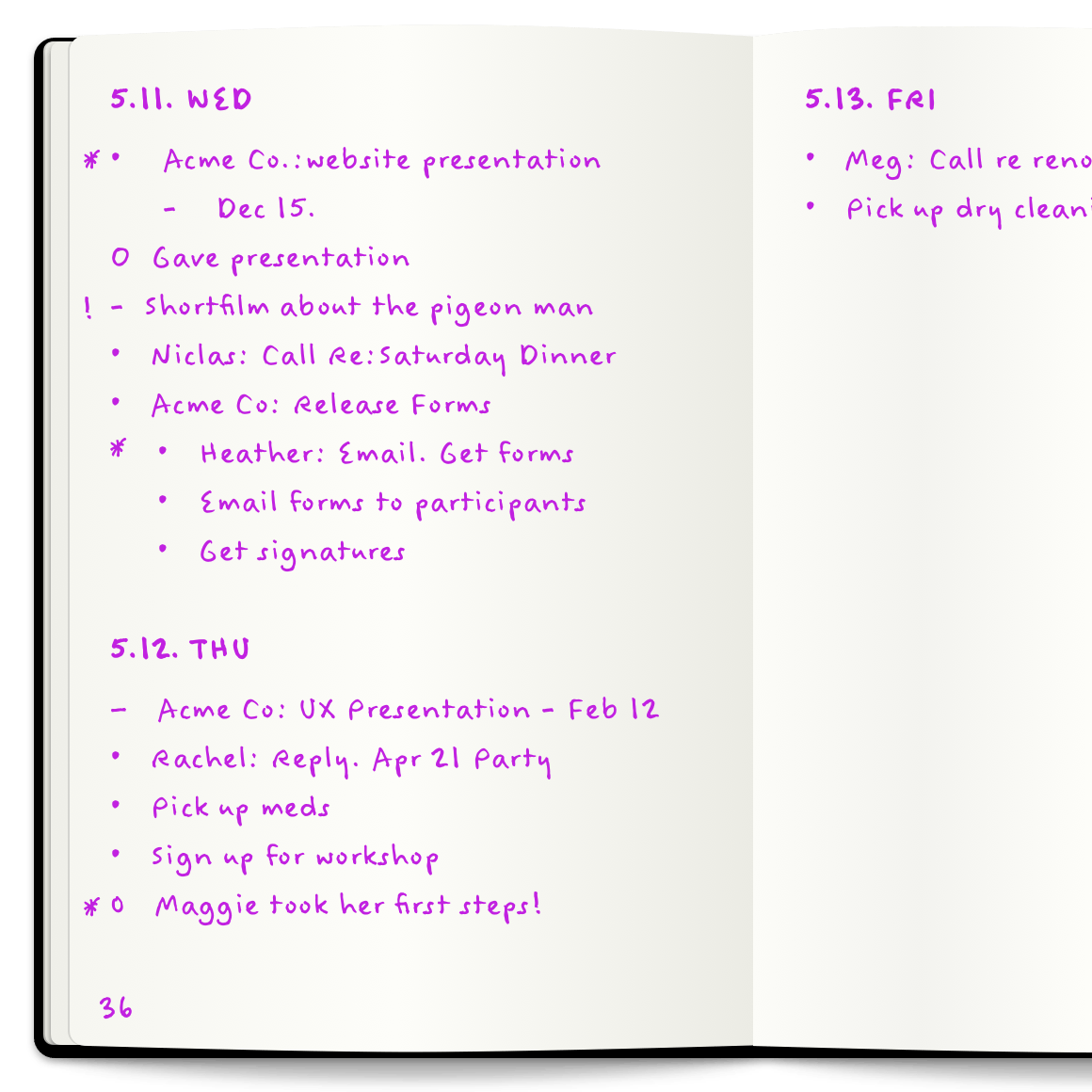
By virtue of Rapid Logging your memorable moments and daily duties, you have created a daily spread. This section is the beating heart of the page. The next step is considering exactly which extremities you want to your daily layout to complement your productivity. Ryder Carroll writes, in The Bullet Journal Method:
“The purpose of the Bullet Journal must be defined by you […] Strip away everything that doesn’t support your purpose. Start simple. Build slowly. Your practice doesn’t need to be profound, or beautiful. It needs to be real, relevant, and effective […] It’s not about how your Bullet Journal looks, it’s about how it makes you feel.”
Here are some common bullet journal ideas for the daily spread
1. Time-based Tasking
One popular method is simply presenting your day as hourly increments. From here, you can use the page as a schedule. You can color-code your time, allocating specific tasks to certain times of the day. Here's one featured on ForeverGoodLife:
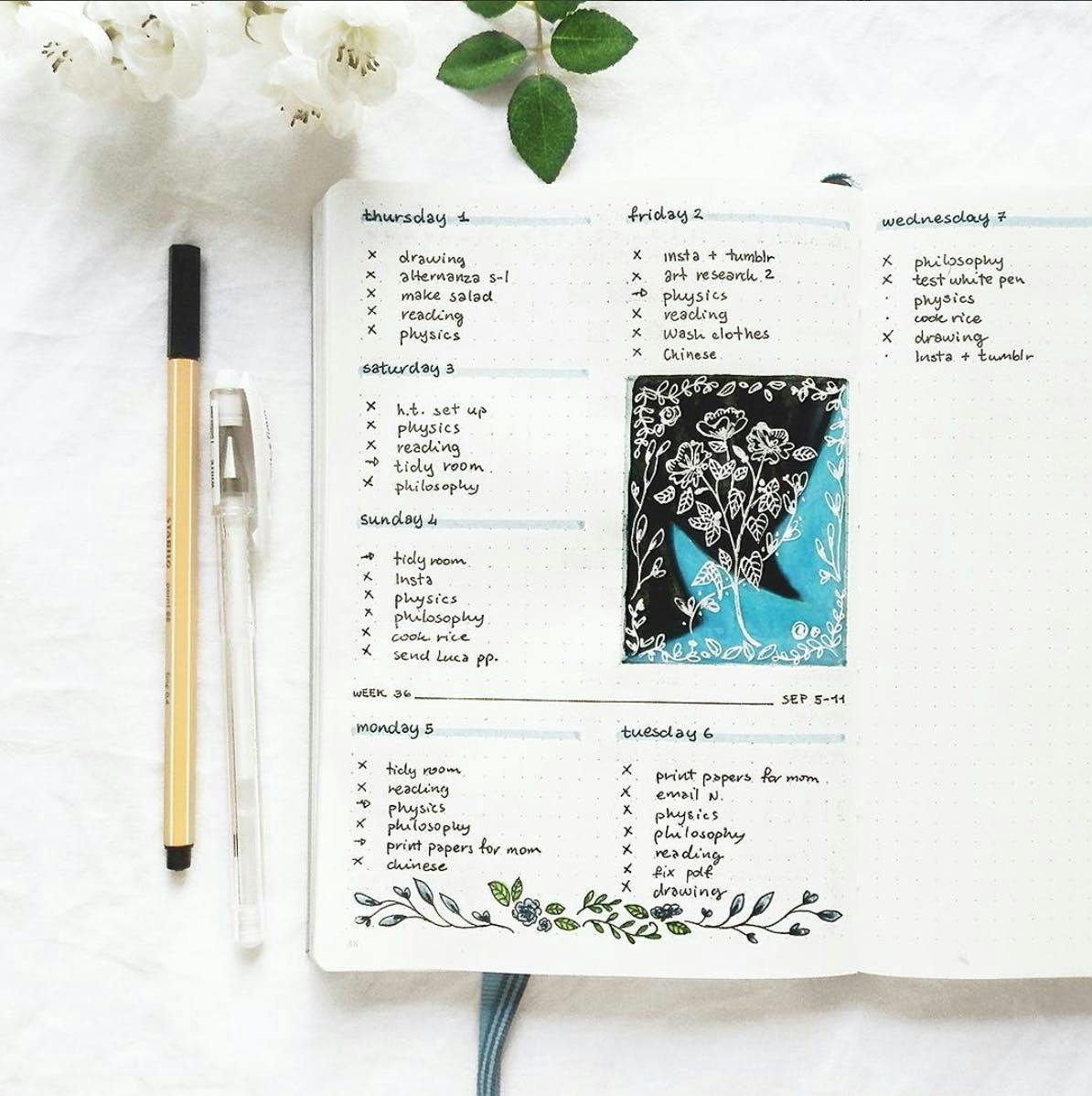
2. Modular
An alternative approach to the daily spread may be one that includes small sketches, visual aids and more free-form task management practices, such as a “brain dump”. A modular design will allow you to assign sections to their specific space, so that you can categorize your productivity respective to the different aspects of your life. If your goals shift, you can swap out sections that no longer apply for more pertinent and valuable matters. The example below is from Space and Quiet:
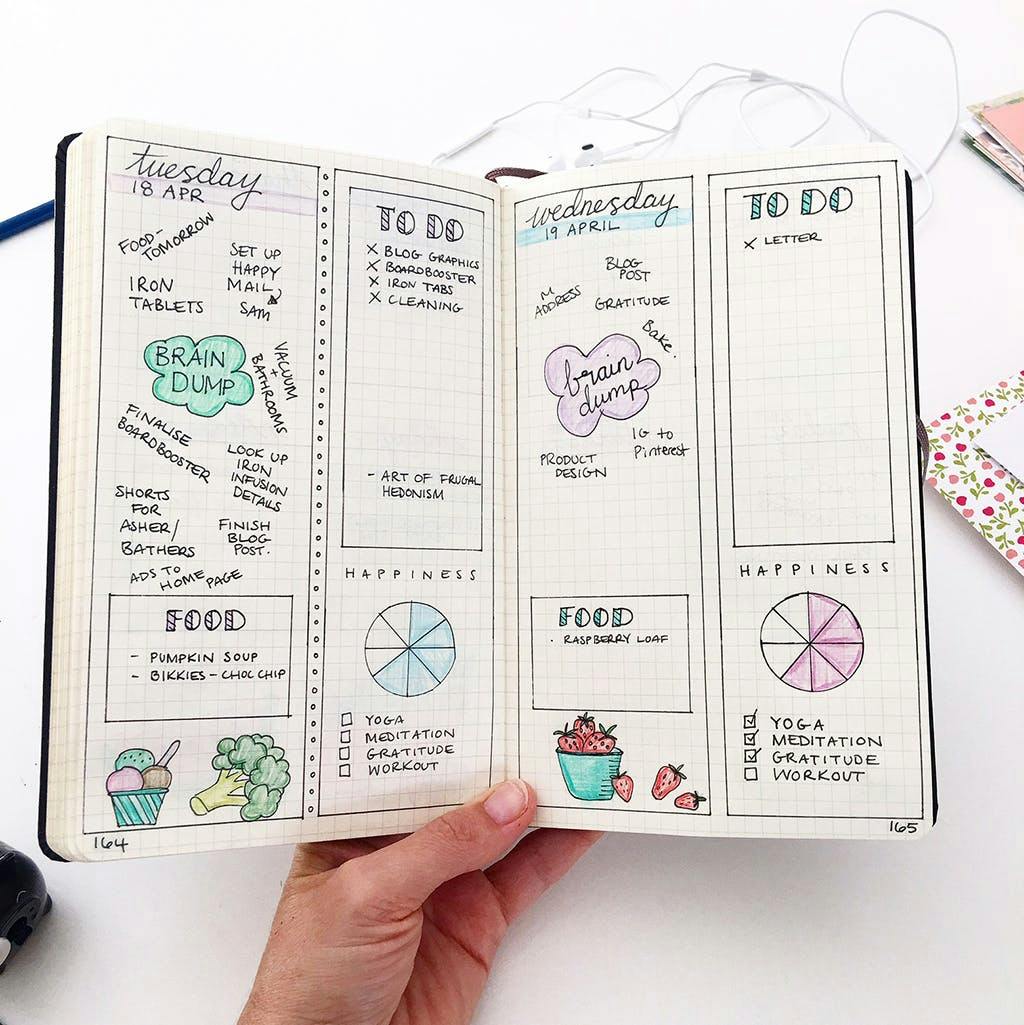
3. Minimalist
Bullet Journaling is all about choosing the right components, but for some it’s as much about what you don’t include. Minimalist methods are clear-cut, for those who admire clean, straight edges and perfect squares. Minimalist spreads work for those who prioritize function over form and more concerned with what the information is, rather than how it’s conveyed. This image is from Journalspiration:
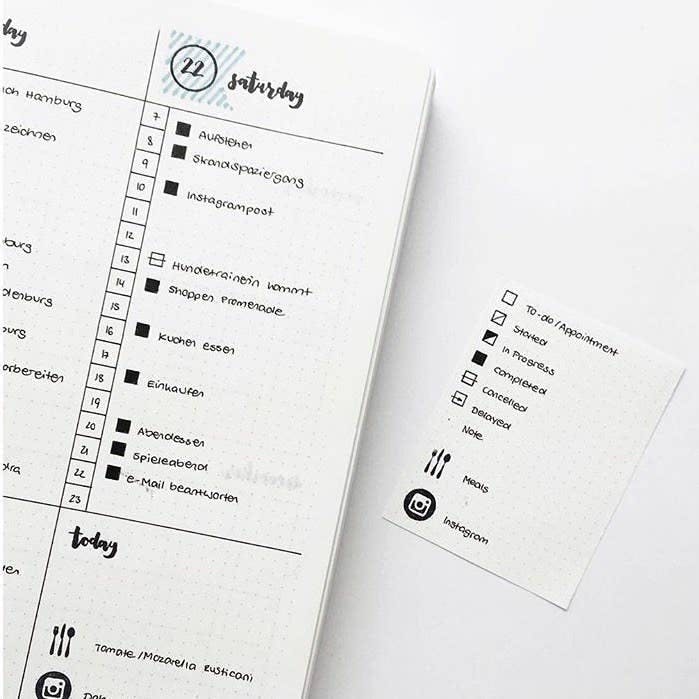
4. Daily-Weekly Combined
Strictly speaking, a daily spread should translate as one day per page, some find it useful to forego this style and present their days within a weekly spread. However, you must avoid completing the entire week at once. From the Bullet Journal website:
“Don’t set up Daily Logs way ahead of time. Create them as you go or the night before.”
The main principle of bullet journaling is the improvement of long-term productivity through ‘migration’, the act of transferring incomplete tasks into a new day or month. Doing this on a daily basis keeps those tasks at the forefront of your consciousness, so you get them done faster.

How To Use a Digital Bullet Journal Spread
In a world increasingly attached to digital format, many are looking towards online platforms to create their daily spreads, which can offer additional tools to further increase your productivity and success.
The far more flexible format is the clear winner in the professional space. It’s becoming ever more prevalent for professionals to use these kinds of interfaces, as work journaling becomes a new norm for remote workers and non-traditional workforces.
The structure of digital BuJo is essentially different because of the format’s innovations. Just as some jokes don’t translate between languages, added functionality such as navigation bars, app integration and metadata engines have no alternative in the analogue counterpart. It’s the difference between steam and electric.
- Versatile structure
With paper journals, you are provided two options: blank page, or pre-structured. It can be hard to springboard from a blank page, and some journals may not use a layout that best suits your personality. With digital, you can adapt and create a space to suit your personal needs.
- Full app integration
You can enjoy seamless linking of apps, which is especially useless in working scenarios, whereby you are required to connect and collaborate with your team
- Automated reminders
Set reminders for certain tasks or time limits that help you stay mindful of your schedule and train efficiency.
- Sophisticated Archiving
Easily return to earlier entries to migrate your ideas or check progress by searching for a keywords or using tags
How To Use a Bullet Journal in Friday
Watch the video below to see how it all works!
1. Use the daily planner as your daily bullet journal. In the Friday planner, you can see meetings, tasks, routines, and goals in one place.
2. Integrate your tools--such as the Google Calendar, Outlook/Microsoft To Do, Todoist, Asana, ClickUp, Trello and more to come.
3. Get the Friday Chrome extension and have your tasks and meetings open with every tab.
4. Set routines and enter text responses as a daily check-in, end of the week reflection, for morning gratitude, and lots more templates to choose from.
Check out this complete explanation of how Friday can work as a digital bullet journal.
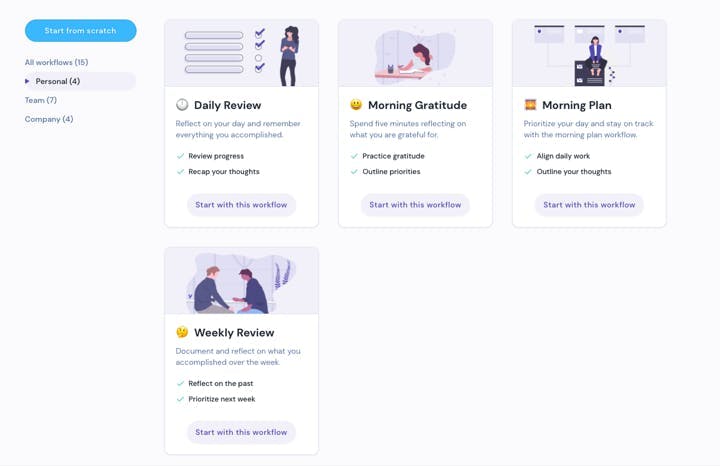
What are the Benefits of Bullet Journaling?
1. Increased Productivity
As with any kind of planning or forethought, using a daily spread will boost your ability to get things done. The American Psychological Association writes that research is showing that establishing a habit of writing about goals can boost performance because people become self-coaches, more self-aware about their behaviours.
Avid Journalist Nicole Barlettano, creator of ‘Plans that Blossom’, is personally benefitting from this effect: “I just love crossing things off a list,” she writes, “I used to put things on my to-do list after I’ve done them, just so that I can cross them out.”
Checking off your goals fills you with that familiar sense of accomplishment. Keep providing yourself with this satisfaction, by continuously setting and completing tasks on your daily spread, and you become conditioned to want to hit your targets.
2. Mightier Memory
We are constantly absorbing, retaining and forgetting information, sometimes with seemingly little control over what is remembered or forgotten. We’re all familiar with the idea of writing something down so we can read our notes later. However, you could be surprised to learn that even the process of writing promotes the ability to later recall that information.
Mark Bohay, Daniel P. Blakely and others found, in their study on note-taking and memory that the “analysis suggests that more note-taking provides a later performance benefit,” which was “broadly consistent with a wide range of findings that active interaction improves memory.”
3. Creating Healthier Habits
The act of writing has long been shown to offer significant health benefits. In his seminal text Opening Up: The Healing Power of Expressing Emotions, esteemed psychologist James W. Pennebaker noted that “dozens of writing experiments have now been conducted by researchers in laboratories around the world [which shown that] not only are their benefits to health, but writing about emotional topics has been found to reduce anxiety and depression.”
A number of unexpected benefits have also been attributed to the continued practice of expressive writing, including weight-loss and healing wounds. Of course, keeping a journal is not witchcraft, and it won’t instantly solve all of your problems. Annette Stanton, professor in health psychology, acknowledges that the benefits are dependent of individual circumstances .
By actively keeping track of habits, you begin to observe yourself from a new perspective. Not only do you become more critical of your undesired behaviour, you are inherently more likely to accept self-criticism.
No one disputes the beauty and sheer creativity behind the pen and page, the pros of physical handwriting, or the need to take a break from your screen. Yet, only digital format can combine an intimate, personal journal with the unmatched convenience of the web.
Whether you decide use digital or paper journals, the important thing is how you interact with it to keep yourself on track. BuJo is a toolkit and the tools utilised are specific to the individual; but the crucial distinction between the productive and the sedentary is the application of these tools.

